Invacare TDX SP User Manual
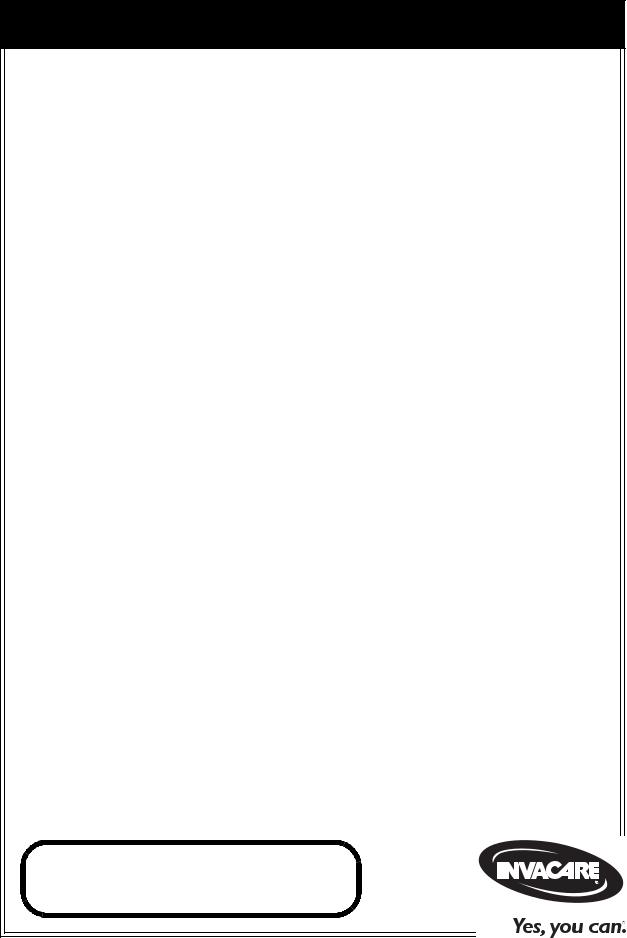
Owner’s Operator and Maintenance Manual
TDX™ SP
Power Wheelchair Base
DEALER: This manual MUST be given to the user of the wheelchair.
USER: BEFORE using this wheelchair, read this manual and save for future reference.
For more information regarding Invacare products, parts, and services, please visit www.invacare.com

REFERENCE DOCUMENTS
WARNING
A QUALIFIED TECHNICIAN MUST PERFORM THE INITIAL SET UP OF THIS WHEELCHAIR. ALSO, A QUALIFIED TECHNICIAN MUST PERFORM ALL PROCEDURES IN THE SERVICE MANUAL.
WHEELCHAIR USERS: DO NOT SERVICE OR OPERATE THIS EQUIPMENT WITHOUT FIRST READING AND UNDERSTANDING
(1) THE OWNER’S OPERATOR AND MAINTENANCE MANUAL AND (2) THE SEATING SYSTEM’S MANUAL (IF APPLICABLE). IF YOU ARE UNABLE TO UNDERSTAND THE WARNINGS, CAUTIONS, AND INSTRUCTIONS, CONTACT INVACARE TECHNICAL SUPPORT BEFORE ATTEMPTING TO SERVICE OR OPERATE THIS EQUIPMENT - OTHERWISE INJURY OR DAMAGE MAY RESULT.
DEALERS AND QUALIFIED TECHNICIANS: DO NOT SERVICE OR OPERATE THIS EQUIPMENT WITHOUT FIRST READING AND UNDERSTANDING (1) THE OWNER’S OPERATOR AND MAINTENANCE MANUAL, (2) THE SERVICE MANUAL (IF APPLICABLE) AND (3) THE SEATING SYSTEM’S MANUAL (IF APPLICABLE). IF YOU ARE UNABLE TO UNDERSTAND THE WARNINGS, CAUTIONS AND INSTRUCTIONS, CONTACT INVACARE TECHNICAL SUPPORT BEFORE ATTEMPTING TO SERVICE OR OPERATE THIS EQUIPMENT - OTHERWISE, INJURY OR DAMAGE MAY RESULT.
REFERENCE DOCUMENTS
Refer to the table below for part numbers of additional documents which are referenced in this manual.
MANUAL |
PART NUMBER |
|
|
MK6i™ Electronics Programming Guide |
1141471 |
|
|
MK6i™ Electronics Service Manual |
1143203 |
|
|
Adjustable ASBA Owner’s Manual |
1143196 |
|
|
Van Seat Owner’s Manual |
1143195 |
|
|
Formula™ CG Seating System |
1143155 |
|
|
TDX SP Service Manual |
1143209 |
|
|
Adjustable ASBA Service Manual |
1143238 |
|
|
NOTE: Updated versions of this manual are available on www.invacare.com.
TDX™ SP |
2 |
Part No 1143190 |

TABLE OF CONTENTS |
|
TABLE OF CONTENTS |
|
REFERENCE DOCUMENTS ................................................................. |
2 |
REGISTER YOUR PRODUCT................................................................ |
6 |
SPECIAL NOTES ................................................................................ |
9 |
LABEL LOCATIONS ......................................................................... |
11 |
All Wheelchairs......................................................................................................................................... |
11 |
Wheelchairs with TRRO ........................................................................................................................ |
13 |
Wheelchairs without TRRO.................................................................................................................. |
13 |
TYPICAL PRODUCT PARAMETERS .................................................. |
14 |
SECTION 1—GENERAL GUIDELINES ................................................. |
15 |
Repair or Service Information ............................................................................................................... |
15 |
Operation Information............................................................................................................................ |
16 |
Wheelchairs with TRRO or TRBKTS Only................................................................................... |
17 |
Tire Pressure ............................................................................................................................................. |
17 |
Electrical ..................................................................................................................................................... |
18 |
Grounding Instructions....................................................................................................................... |
18 |
Batteries...................................................................................................................................................... |
18 |
Charging Batteries ............................................................................................................................... |
18 |
Rain Test..................................................................................................................................................... |
19 |
Weight Training ........................................................................................................................................ |
19 |
Weight Limitation..................................................................................................................................... |
19 |
SECTION 2—EMI INFORMATION ..................................................... |
20 |
SECTION 3—SAFETY/HANDLING OF WHEELCHAIRS ......................... |
22 |
Stability and Balance................................................................................................................................. |
22 |
Coping with Everyday Obstacles .......................................................................................................... |
23 |
A Note to Wheelchair Assistants ........................................................................................................ |
24 |
Reaching, Leaning and Bending - Forward .......................................................................................... |
24 |
Reaching, Bending - Backward............................................................................................................... |
25 |
Pinch Points................................................................................................................................................ |
25 |
Stairways..................................................................................................................................................... |
26 |
Transferring To and From Other Seats .............................................................................................. |
27 |
Part No 1143190 |
3 |
TDX™ SP |

TABLE OF CONTENTS
TABLE OF CONTENTS |
|
SECTION 4—SAFETY INSPECTION/TROUBLESHOOTING .................... |
28 |
Safety Inspection Checklists................................................................................................................... |
28 |
Inspect/Adjust Initially ......................................................................................................................... |
28 |
Inspect/Adjust Weekly........................................................................................................................ |
29 |
Inspect/Adjust Monthly....................................................................................................................... |
29 |
Inspect/Adjust Periodically................................................................................................................. |
30 |
Inspect/Adjust Every 18 Months....................................................................................................... |
30 |
Inspect/Adjust Every 2 Years ............................................................................................................ |
30 |
Troubleshooting - Mechanical .............................................................................................................. |
30 |
Troubleshooting - Electrical................................................................................................................... |
31 |
SPJ™+, SPJ+ w/PSS or SPJ+ w/ACC Joysticks .............................................................................. |
31 |
MPJ™+, PSR+, PSF+ Joysticks or Displays..................................................................................... |
32 |
Checking Battery Charge Level............................................................................................................. |
34 |
SECTION 5—WHEELCHAIR OPERATION ........................................... |
35 |
Operating the Wheelchair...................................................................................................................... |
35 |
Turning the Power On/Off................................................................................................................ |
35 |
Using the Joystick to Drive the Wheelchair.................................................................................. |
35 |
SPJ+, MK6i™ SPJ+ w/PSS and MK6i SPJ+ w/ACC Joystick Switches and Indicators ............... |
37 |
On/Off Button ...................................................................................................................................... |
37 |
Speedometer......................................................................................................................................... |
37 |
Speed Control Buttons....................................................................................................................... |
38 |
Joystick.................................................................................................................................................... |
38 |
Charger/Programming Input.............................................................................................................. |
38 |
Service Indicator................................................................................................................................... |
38 |
Information Gauge Display ................................................................................................................ |
39 |
MPJ+ Joystick Switches and Indicators ................................................................................................ |
39 |
Drive Select Toggle Switch................................................................................................................ |
39 |
Speed Control ...................................................................................................................................... |
40 |
Joystick.................................................................................................................................................... |
40 |
Charger/Programming Input.............................................................................................................. |
40 |
LCD Display Screens........................................................................................................................... |
40 |
Programmable Mono Port 1/2 or External Mode Switch........................................................... |
43 |
Remote On/Off Switch....................................................................................................................... |
44 |
Mode Switch.......................................................................................................................................... |
44 |
Memory Card Slot ............................................................................................................................... |
44 |
Repositioning Joystick.............................................................................................................................. |
45 |
Van Seats................................................................................................................................................ |
45 |
Adjustable ASBA Seats........................................................................................................................ |
46 |
Disconnecting/Connecting the Joysticks ............................................................................................. |
46 |
SPJ+ Joysticks ........................................................................................................................................ |
46 |
MPJ+ Joysticks....................................................................................................................................... |
47 |
TDX™ SP |
4 |
Part No 1143190 |

TABLE OF CONTENTS |
|
TABLE OF CONTENTS |
|
SECTION 6—MOTOR LOCKS ............................................................ |
48 |
Disengaging/Engaging Motor Lock Levers........................................................................................... |
48 |
SECTION 7—WHEEL LOCKS ............................................................. |
49 |
Disengaging/Engaging the Wheel locks................................................................................................ |
49 |
Engaging.................................................................................................................................................. |
49 |
Disengaging............................................................................................................................................ |
49 |
SECTION 8—FOOTBOARD ASSEMBLY .............................................. |
50 |
Removing/Installing the Footboard....................................................................................................... |
50 |
Removing ............................................................................................................................................... |
50 |
Installing.................................................................................................................................................. |
50 |
Adjusting the Footboard Angle ............................................................................................................. |
51 |
SECTION 9—FORKS ........................................................................ |
52 |
Adjusting Forks ......................................................................................................................................... |
52 |
SECTION 10—BATTERIES ................................................................ |
53 |
Using the Proper Batteries..................................................................................................................... |
54 |
Replacing Batteries ................................................................................................................................... |
55 |
Cleaning Battery Terminals.................................................................................................................... |
57 |
Removing/Installing the Batteries From/Into the Wheelchair........................................................ |
57 |
Removing the Front Shroud/Battery Retention Bracket and Rear Shroud............................ |
57 |
Removing the Batteries from Wheelchair ..................................................................................... |
59 |
Installing Batteries into Wheelchair................................................................................................. |
59 |
Installing the Front Shroud/Battery Retention Bracket and Rear Shroud .............................. |
60 |
When to Charge Batteries..................................................................................................................... |
61 |
SPJ+, SPJ+ w/PSS and SPJ+ w/ACC Joysticks................................................................................. |
61 |
MPJ+ Joystick......................................................................................................................................... |
61 |
Charging Batteries.................................................................................................................................... |
62 |
Description and Use of Battery Chargers...................................................................................... |
62 |
Part No 1143190 |
5 |
TDX™ SP |

SECTION 11—TRANSPORT READY PACKAGE (TRRO) ...................... |
64 |
About Transport Ready Packages......................................................................................................... |
65 |
Compliance Information ......................................................................................................................... |
65 |
Specifications......................................................................................................................................... |
66 |
Securing the Wheelchair to the Vehicle ............................................................................................. |
66 |
Positioning the Wheelchair in the Vehicle..................................................................................... |
66 |
Securement Points............................................................................................................................... |
67 |
Securing the Wheelchair .................................................................................................................... |
67 |
Securing the Occupant ............................................................................................................................ |
68 |
Wheelchair-Anchored Belts.............................................................................................................. |
68 |
Vehicle-Anchored Belts...................................................................................................................... |
70 |
Seating System ...................................................................................................................................... |
70 |
Positioning Belts ................................................................................................................................... |
71 |
LIMITED WARRANTY ..................................................................... |
72 |
REGISTER YOUR PRODUCT
The benefits of registering:
1.Safeguard your investment.
2.Ensure long term maintenance and servicing of your purchase.
3.Receive updates with product information, maintenance tips, and industry news.
4.Invacare can contact you or your provider, if servicing is needed on your product.
5.It will enable Invacare to improve product designs based on your input and needs.
Register ONLINE at www.invacare.com - or -
Complete and mail the form on the next page
Any registration information you submit will be used by Invacare Corporation only, and protected as required by applicable laws and regulations.
TDX™ SP |
6 |
Part No 1143190 |

Cut Along Line
PRODUCT REGISTRATION FORM
Register ONLINE at www.invacare.com - or -
Complete and mail this form
Name_______________________________________________________________ |
|
||||||
Address _____________________________________________________________ |
|
||||||
City ___________________State/Province __________ |
|
|
|||||
Zip/Postal Code ________ |
|
|
|
|
|
||
Email ___________________________________Phone No. _________________ |
Fold |
||||||
Invacare Model No. ______________________Serial No. __________________ |
here |
||||||
|
|||||||
Purchased From _________________________Date of Purchase:___________ |
|
||||||
|
|
|
|
|
|
||
1. |
Method of purchase: (check all that apply) |
|
|
|
|
||
Medicare |
Insurance |
Medicaid |
Other |
__________________________ |
|
||
2. |
This product was purchased for use by: (check one) |
|
|
|
|||
Self |
Parent |
Spouse |
Other |
|
|
|
|
3. |
Product was purchased for use at: |
|
|
|
|
||
Home |
Facility |
Other |
|
|
|
|
|
4. |
I purchased an Invacare product because: |
|
|
|
|
||
Price |
Features (list features) _________________________________________ |
|
|||||
5. |
Who referred you to Invacare products? (check all that apply) |
|
|
||||
Doctor |
Therapist Friend Relative Dealer/Provider |
Other_________ |
|
||||
Advertisement (circle one): TV, Radio, Magazine, Newspaper |
No Referral_____ |
|
|||||
6.What additional features, if any, would you like to see on this product?
__________________________________________________________________________ Fold
7. |
Would you like information sent to you about Invacare products that may be available for a here |
|
particular medical condition? Yes No |
|
If yes, please list any condition(s) here and we will send you information by email and/or mail about |
|
any available Invacare products that may help treat, care for or manage such condition(s): |
|
__________________________________________________________________________ |
8. |
Would you like to receive updated information via email or regular mail about the Invacare |
|
home medical products sold by Invacare's dealers? Yes No |
9.What would you like to see on the Invacare website?
__________________________________________________________________________
10.Would you like to be part of future online surveys for Invacare products? Yes No
11.User's Year of birth: ______________________________________________________
If at any time you wish not to receive future mailings from us, please contact us at Invacare Corporation, CRM Department, 39400 Taylor Parkway, Elyria, OH 44035, or fax to 877-619-7996 and we will remove you from our mailing list.
To find more information about our products, visit www.invacare.com.
Part No 1143190 |
7 |
TDX™ SP |
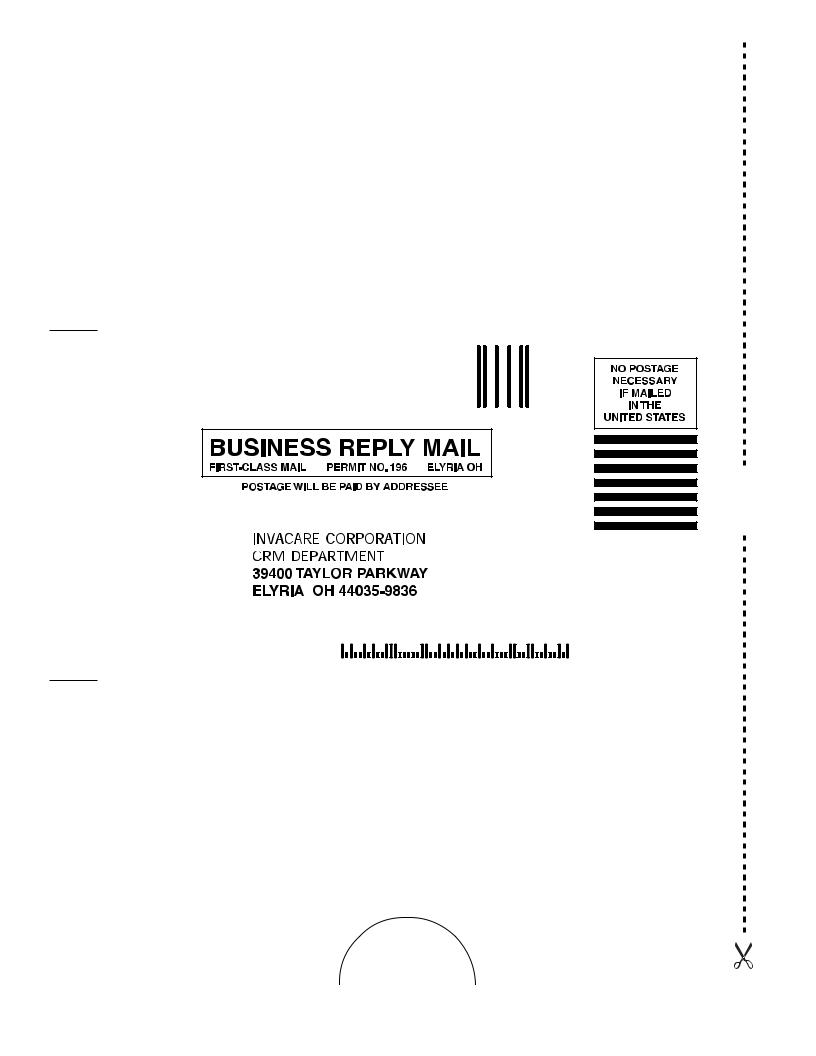
Fold here
 Cut Along Line
Cut Along Line
Fold here
Invacare Product Registration Form
Please Seal with
Tape Before Mailing
TDX™ SP |
8 |
Part No 1143190 |

SPECIAL NOTES
SPECIAL NOTES
Signal words are used in this manual and apply to hazards or unsafe practices which could result in personal injury or property damage. Refer to the table below for definitions of the signal words.
|
SIGNAL WORD |
MEANING |
|
|
|
|
|
Danger indicates an imminently hazardous situation which, if not avoided, |
|
DANGER |
will result in death or serious injury. |
|
|
|
|
|
Warning indicates a potentially hazardous situation which, if not avoided, |
|
WARNING |
could result in death or serious injury. |
|
|
|
|
|
Caution indicates a potentially hazardous situation which, if not avoided, |
|
CAUTION |
may result in property damage. |
|
|
|
|
|
|
NOTICE
THE INFORMATION CONTAINED IN THIS DOCUMENT IS SUBJECT TO CHANGE WITHOUT NOTICE.
WHEELCHAIR USER
As a manufacturer of wheelchairs, Invacare endeavors to supply a wide variety of wheelchairs to meet many needs of the end user. However, final selection of the type of wheelchair to be used by an individual rests solely with the user and his/her healthcare professional capable of making such a selection. Invacare highly recommends working with a certified rehab technology supplier and/or a member of NRRTS or RESNA.
WHEELCHAIR TIE-DOWN RESTRAINTS AND SEAT RESTRAINTS (TRRO OR TRBKTS)
TRRO includes four factory-installed transport brackets and a wheelchair anchored pelvic belt. TRRO has been crash-tested in accordance with ANSI/RESNA WC Vol 1 Section 19 Frontal Impact Test requirements for wheelchairs with a 168 lb crash dummy, which corresponds to a person with a weight of 114 to 209 lbs.
TRBKTS includes four factory-installed wheelchair transport brackets. TRBKTS has not been crash-tested in accordance with WC 19. Use these transport brackets only to secure an unoccupied wheelchair during transport.
As of this date, the Department of Transportation has not approved any tie-down systems for transportation of a user while in a wheelchair, in a moving vehicle of any type. It is Invacare’s position that users of wheelchairs should be transferred into appropriate seating in vehicles for transportation and use be made of the restraints made available by the auto industry. Invacare cannot and does not recommend any wheelchair transportation systems.
Refer to Transport Ready Package (TRRO) on page 64 for more information about transporting the wheelchair.
Part No 1143190 |
9 |
TDX™ SP |

SPECIAL NOTES
TRRO AND TRBKTS WARNINGS
Only use the transport brackets included with TRRO and TRBKTS for the purposes described in this manual.
Battery support brackets MUST be installed at all times. Otherwise, the wheelchair will not be WC/19 compliant. Refer to Removing/Installing the Batteries From/Into the Wheelchair on page 57.
WARNING
Invacare products are specifically designed and manufactured for use in conjunction with Invacare accessories. Accessories designed by other manufacturers have not been tested by Invacare and are not recommended for use with Invacare products.
The seat positioning strap is a positioning belt ONLY. It is not designed for use as a safety device withstanding high stress loads such as auto or aircraft safety belts. If signs of wear appear, belt MUST be replaced IMMEDIATELY.
The drive behavior initially experienced by the user may be different from other wheelchairs previously used. This power wheelchair has Invacare’s SureStep® technology, a feature that provides the wheelchair with optimum traction and stability when driving forward over transitions and thresholds of up to 3-inches. The following warnings apply specifically to the SureStep feature:
•DO NOT use on inclines greater than 9°.
•DO NOT use on inclines with wet, slippery, icy or oily surfaces. This may include certain painted or otherwise treated wood surfaces.
•DO NOT traverse down ramps at high speed. Doing so will reduce traction and increase stopping distance.
•The end user’s weight can materially affect traction on sloped surfaces. Great care should be taken when traversing such slopes.
To determine and establish your particular safety limits, practice use of this product on various sloping surfaces in the presence of a qualified healthcare provider before attempting active use of this wheelchair. Other general warnings listed within this document also apply.
Wheelchairs should be examined during maintenance for signs of corrosion (water exposure, incontinence, etc.). Electrical components damaged by corrosion should be replaced IMMEDIATELY.
Wheelchairs that are used by incontinent users and/or are frequently exposed to water may require replacement of electrical components more frequently.
TDX™ SP |
10 |
Part No 1143190 |
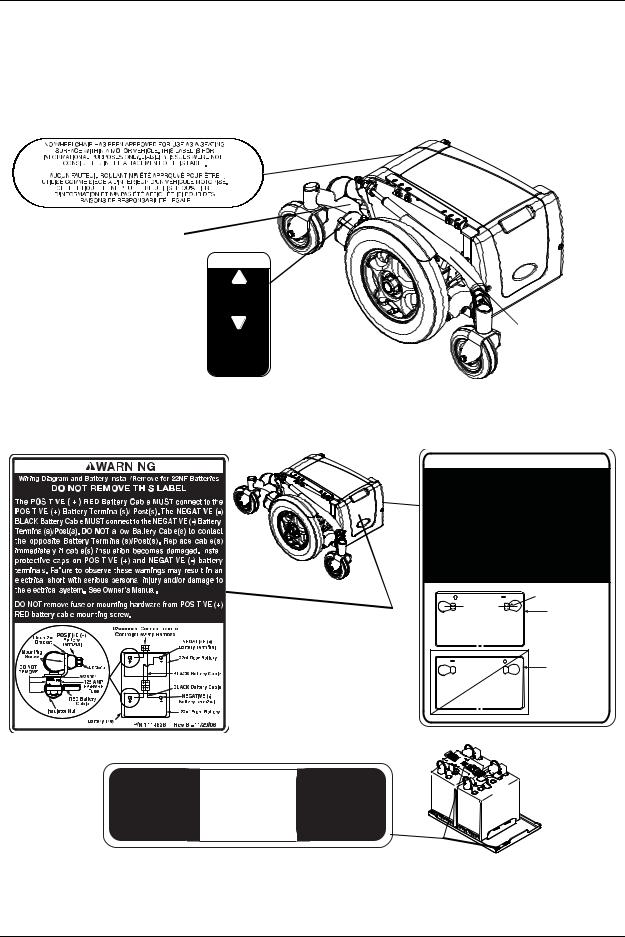
LABEL LOCATIONS
LABEL LOCATIONS
All Wheelchairs
Serial Number Label is  located on the right side rear swingarm.
located on the right side rear swingarm.
 CAUTION
CAUTION
DRIVE PUSH
Ensure both clutches are fully engaged before driving chair
P/N 1118367
Rev A - 3/03
Located on each 4-pole motor
 Weight Capacity Label located here
Weight Capacity Label located here
Wheelchairs with 22NF Batteries
|
|
|
|
|
|
|
|
|
|
|
|
|
|
|
|
|
|
Utiliser les |
|
|
|
|
|
|
|
|
|
|
|
|
|
|
|
|
|
|
|
|
|
|
|
|
|
|
|
|
|
|
|
|
|
|
|
|
|
|
|
|
|
|
|
|
|
|
|
|
|
|
|
|
|
|
|
|
|
|
|
|
|
|
|
|
|
|
|
|
|
|
|
|
|
|
|
|
|
|
|
|
|
|
|
|
|
|
|
|
|
|
|
|
|
|
|
|
|
|
|
|
|
|
|
|
|
|
|
|
|
|
|
|
|
|
|
|
|
|
|
|
|
|
|
|
|
|
|
|
|
|
|
|
|
|
|
Use 22NF |
|
1118356P/N |
|
1118356P/N 8/04-BREV |
|
|||||||||||
|
|
|
||||||||||||||||
|
Batteries Only. |
|
|
batteries 22NF |
||||||||||||||
|
See Owner's |
|
|
|
|
seulement. Se |
||||||||||||
|
|
|
Manual. |
|
|
|
référer au manuel |
|||||||||||
|
|
|
|
|
|
|
|
|
|
|
|
|
|
|
|
|
de l'utilisateur. |
|
 WARNING
WARNING
22NF batteries with terminal configuration (positive on the left and negative on the right) as shown MUST be used. 22NF batteries that have the reverse terminal configuration MUST not be used. Terminals MUST have a cross hole located as shown for proper battery connection. See Owner's Manual. These recommendations MUST be followed otherwise injury and/or damage may occur.
P/N 1114847 Rev B - 2/04
Cross Hole
Positive |
Negative |
USE this |
|
battery |
|||
Terminal |
Terminal |
||
terminal |
|||
|
|
||
|
|
configuration |
|
|
DO NOT use |
Negative |
Positive |
this battery |
Terminal |
Terminal |
terminal |
|
|
configuration |
Part No 1143190 |
11 |
TDX™ SP |
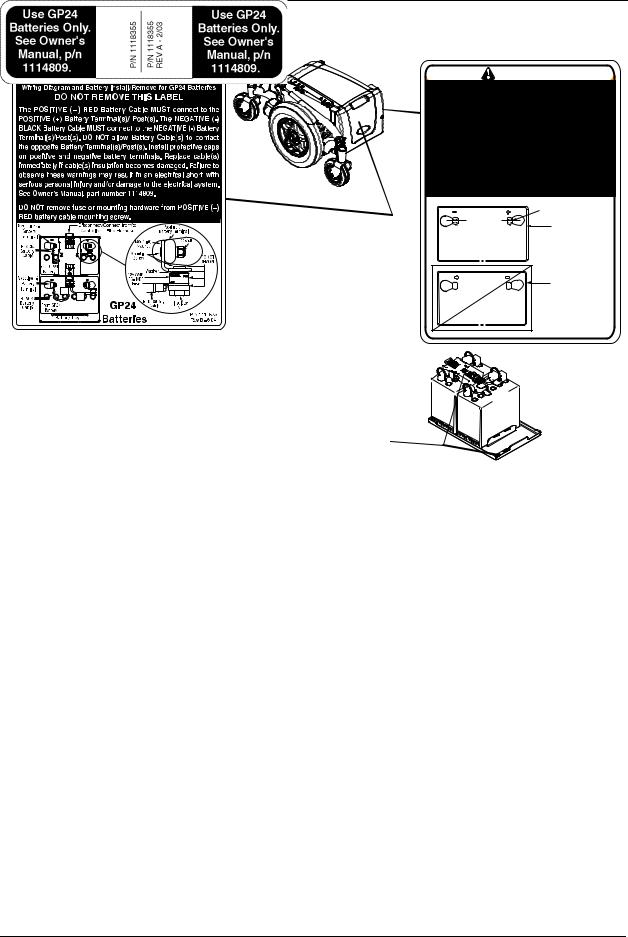
LABEL LOCATIONS
Wheelchairs with GP24 Batteries
USE this
Negative |
Positive |
battery |
|
Terminal |
Terminal |
||
terminal |
|||
|
|
||
|
|
configuration |
|
|
DO NOT use |
|
Positive |
Negative |
this battery |
|
terminal |
|||
Terminal |
Terminal |
||
|
|
configuration |
TDX™ SP |
12 |
Part No 1143190 |
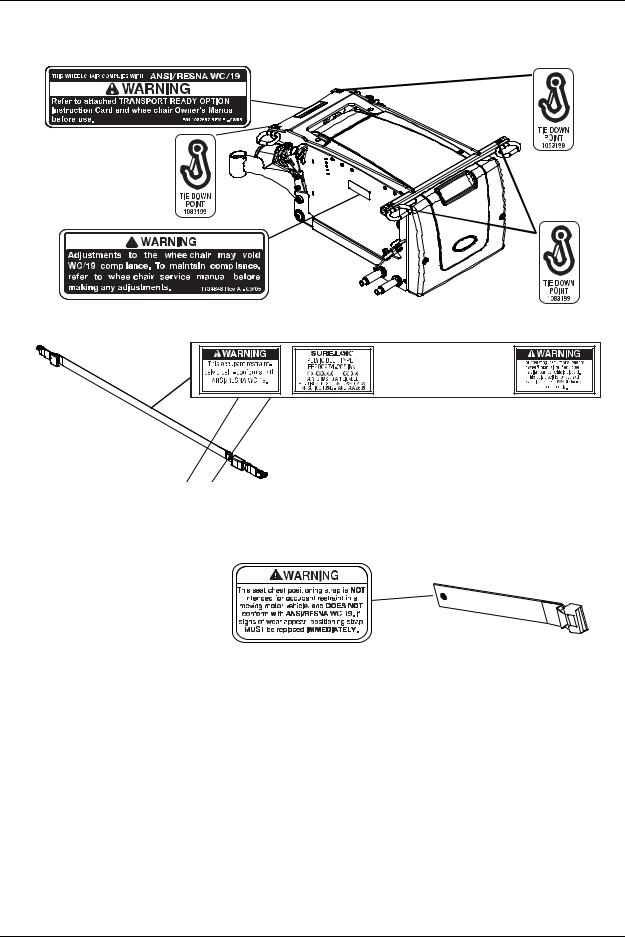
LABEL LOCATIONS
Wheelchairs with TRRO
NOTE: Also on opposite side.
Wheelchairs without TRRO
NOTE: Auto style seat positioning strap shown. This label is also on the airline style seat positioning strap.
Part No 1143190 |
13 |
TDX™ SP |

TYPICAL PRODUCT PARAMETERS
TYPICAL PRODUCT PARAMETERS
BASE LENGTH: |
|
35.25 inches |
|
|
|
|
|
OVERALL WIDTH OF BASE: |
|
|
|
TDS SP WITH TWO 22NF BATTERIES: |
24 inches without joystick |
||
TDX SP WITH TWO GP24 BATTERIES OR |
|
|
|
WITH THREE 22NF BATTERIES: |
25.5 inches without joystick |
||
|
|
|
|
OVERALL HEIGHT |
|
|
|
WITH ASBA SEAT: |
35.5 to 39.5 inches |
||
WITH VAN SEAT: |
38 inches (with head rest), 45 inches (with head rest) |
||
WITH FORMULA CG TILT ONLY: |
36.5 to 40.5 inches |
||
WITH ELEVATING ASBA SEAT: |
35.5 to 41.5 inches |
||
|
|
|
|
OVERALL LENGTH |
|
|
|
WITH CENTER MOUNT FRONT RIGGING: |
|
42.9 inches @ 0° |
|
WITHOUT FRONT RIGGINGS: |
|
35.25 inches |
|
|
|
|
|
WEIGHT (BASE ONLY) |
|
|
|
WITHOUT 22NF BATTERIES: |
|
123 lbs |
|
WITH TWO 22NF BATTERIES: |
|
221 lbs |
|
WITHOUT GP24 BATTERIES: |
|
158 lbs |
|
WITH TWO GP24 BATTERIES: |
|
260 lbs |
|
WITH TRANSPORT READY OPTION: |
|
Add 10 lbs |
|
|
|
||
MOTOR: |
4 Pole, HD 4 Pole |
||
|
|
|
|
DRIVE AXLE: |
|
Non-adjustable |
|
|
|
||
DRIVE WHEELS/TIRES: |
14 x 3-inch Foam Filled or Pneumatic (Standard) |
||
|
|
||
CASTERS: |
6 x 2-inch, Semi-pneumatic with Precision Sealed Bearings |
||
|
|
||
CASTER FORKS: |
Two side fork (Standard), One sided fork (Optional) |
||
|
|
||
BATTERY REQUIREMENTS: |
Use MK p/n M24SLDG or p/n M22NFSLDG batteries only. |
||
|
|
||
FOOTRESTS: |
Telescoping Front Rigging Supports, |
||
|
2-inch and 4-inch long Pivot Slide Tube |
||
|
|
||
SEAT TILT ANGLE ADJUSTMENT: |
Adjustable (0° to 10°) |
||
|
|
|
|
*WEIGHT LIMITATION |
4 POLE |
|
HD 4 POLE |
WITH ASBA SEAT: |
Up to 300 lbs |
|
Up to 400 lbs |
WITH ASBA JR. SEAT |
Up to 150 lbs |
|
N/A |
WITH VAN SEAT: |
Up to 300 lbs |
|
Up to 400 lbs |
WITH FORMULA™ CG POWERED SEATING: |
Up to 300 lbs |
|
Up to 400 lbs |
WITH ELEVATING ASBA SEAT: |
Up to 300 lbs |
|
N/A |
|
|
|
|
NOTE: All dimensions are ±.50 inches unless otherwise indicated.
*NOTE: Weight limitation is total weight (user weight plus any additional items that the user may require [back pack, etc.]). Example: If weight limitation of the wheelchair is 300 lbs and additional items equal 25 lbs, subtract 25 lbs from 300 lbs. This means the maximum weight limitation of the user is 275 lbs.
TDX™ SP |
14 |
Part No 1143190 |

SECTION 1—GENERAL GUIDELINES
SECTION 1—GENERAL GUIDELINES
WARNING
SECTION 1 - GENERAL GUIDELINES contains important information for the safe operation and use of this product. DO NOT use this product or any available optional equipment without first completely reading and understanding these instructions and any additional instructional material such as Owner’s Manuals, Service Manuals or Instruction Sheets supplied with this product or optional equipment. If you are unable to understand the Warnings, Cautions or Instructions, contact a healthcare professional, dealer or technical personnel before attempting to use this equipment - otherwise, injury or damage may occur.
Repair or Service Information
Set up of the Electronics Control Unit is to be performed only by a qualified technician. The final adjustments of the controller may affect other activities of the wheelchair. Damage to the equipment could occur if improperly set up or adjusted.
Except for programming, DO NOT service or adjust the wheelchair while occupied, unless otherwise noted.
A pinch point exists between head tube cap and walking beam.
A pinch point exists between walking beam/head tube cap and telescoping tube when TDX is at the lowest seat to floor height.
Before adjusting, repairing or servicing the wheelchair, ALWAYS turn the wheelchair power Off, otherwise, injury or damage may occur.
Invacare products are specifically designed and manufactured for use in conjunction with Invacare accessories. Accessories designed by other manufacturers have not been tested by Invacare and are not recommended for use with Invacare products.
Transport ready packages are not retrofittable to existing models and are not field serviceable.
Battery retention brackets MUST be installed at all times. Otherwise, the wheelchair will not be WC/19 compliant. Refer to Removing/Installing the Batteries From/Into the Wheelchair on page 57.
Wheelchairs should be examined during maintenance for signs of corrosion (water exposure, incontinence, etc.). Electrical components damaged by corrosion should be replaced IMMEDIATELY.
Wheelchairs that are used by incontinent users and/or are frequently exposed to water may require replacement of electrical components more frequently.
For optimum performance, replace gas locking cylinders every 2 years.
Part No 1143190 |
15 |
TDX™ SP |

SECTION 1—GENERAL GUIDELINES
Operation Information
Performance adjustments should only be made by professionals of the healthcare field or persons fully conversant with this process and the driverʹs capabilities. Incorrect settings could cause injury to the driver, bystanders, damage to the wheelchair and to surrounding property.
After the wheelchair has been set up/adjusted, check to make sure that the wheelchair performs to the specifications entered during the set up procedure. If the wheelchair does NOT perform to specifications, turn the wheelchair Off immediately and reenter set up specifications. Repeat this procedure until the wheelchair performs to specifications.
DO NOT leave the power button On when entering or exiting your wheelchair.
DO NOT attempt to drive over curbs or obstacles greater than 3 inches. Doing so may cause your wheelchair to turn over and cause bodily harm or damage to the wheelchair. ALWAYS stop before climbing an obstacle. Approach slowly until casters contact the obstacle. Apply power and the action of the SureStep feature will lift the casters over the obstacle. Weight is transferred to the drive wheels providing traction and motor strength to power the wheelchair over the obstacle.
DO NOT operate on roads, streets or highways.
DO NOT climb, go up or down ramps or traverse slopes greater than 9°.
DO NOT attempt to move up or down an incline with water, ice or oil film.
DO NOT stand on the frame of the wheelchair.
DO determine and establish your particular safety limits by practicing bending, reaching and transferring activities in the presence of a qualified healthcare professional before attempting active use of the wheelchair.
DO NOT attempt to reach objects if you have to move forward in your seat.
DO NOT attempt to reach objects if you have to pick them up from the floor by reaching between your knees.
DO NOT lean over the top of the back upholstery to reach objects behind you, as this may cause the wheelchair to tip over.
ALWAYS shift your weight in the direction you are turning. DO NOT shift your weight in the opposite direction of the turn. Shifting your weight in the opposite direction of the turn may cause the inside drive wheel to lose traction and the wheelchair to tip over.
DO NOT shift your weight or sitting position toward the direction you are reaching as the wheelchair and/or seating system (if any) may tip over.
DO NOT use an escalator to move a wheelchair between floors. Serious bodily injury may occur.
DO NOT use the footplates as a platform. When getting in or out of the wheelchair, make sure that the footplates are in the upward position or swing footrests towards the outside of the wheelchair.
NEVER leave an unoccupied wheelchair unattended on an incline.
TDX™ SP |
16 |
Part No 1143190 |

SECTION 1—GENERAL GUIDELINES
DO NOT attempt to stop a moving wheelchair with the wheel locks. Wheel locks are not brakes.
DO NOT attempt to lift the wheelchair by any removable (detachable) parts. Lifting by means of any removable (detachable) parts of the wheelchair may result in injury to the user or damage to the wheelchair.
DO NOT overtighten hardware attaching to the frame. This could cause damage to the frame tubing.
ALWAYS keep hands and fingers clear of moving parts to avoid injury.
ALWAYS wear your seat positioning strap. The seat positioning strap is a positioning belt ONLY. It is not designed for use as a safety device withstanding high stress loads such as auto or aircraft safety belts. If signs of wear appear, belt MUST be replaced immediately.
ALWAYS turn the wheelchair power off and engage the motor locks/clutches to prevent the wheels from moving before attempting to transfer in or out of the wheelchair. Also make sure every precaution is taken to reduce the gap distance. Align both casters parallel with the object you are transferring onto.
DO NOT use with a broken or missing joystick knob.
DO NOT use if joystick does not spring back to the neutral position or becomes sticky or sluggish.
DO NOT use if joystick boot is torn or damaged.
ALWAYS check foam grips for looseness before using the wheelchair. If loose, contact a qualified technician for instructions.
ALWAYS engage both wheel locks and reduce the gap distance before transferring to and from the wheelchair. Turn all casters parallel to the object you are transferring onto.
Avoid storing or using the wheelchair near open flame or combustible products. Serious injury or damage to property may result.
DO NOT engage or disengage the motor locks until the power is in the off position.
Wheelchairs with TRRO or TRBKTS Only
Only use the transport brackets included with TRRO and TRBKTS for the purposes described in this manual.
Tire Pressure
DO NOT use your wheelchair unless it has the proper tire pressure (P.S.I.). DO NOT overinflate the tires. Failure to follow these recommendations may cause the tire to explode and cause bodily harm. The recommended tire pressure is listed on the side wall of the tire.
Part No 1143190 |
17 |
TDX™ SP |

SECTION 1—GENERAL GUIDELINES
Electrical
Grounding Instructions
DO NOT, under any circumstances, cut or remove the round grounding prong from any plug used with or for Invacare products. Some devices are equipped with three prong (grounding) plugs for protection against possible shock hazards. Where a two prong wall receptacle is encountered, it is the personal responsibility and obligation of the customer to contact a qualified electrician and have the two prong receptacle replaced with a properly grounded three prong wall receptacle in accordance with the National Electrical Code. If you must use an extension cord, use only a three wire extension cord having the same or higher electrical rating as the device being connected. In addition, Invacare has placed RED/ORANGE warning tags on some equipment. DO NOT remove these tags.
Batteries
The warranty and performance specifications contained in this manual are based on the use of deep cycle gel cell batteries. Invacare strongly recommends their use as the power source for this unit.
Carefully read battery/battery charger information prior to installing, servicing or operating your wheelchair.
Charging Batteries
DANGER
When using an extension cord, use only a three wire extension cord having at least 16 AWG (American Wire Gauge) wire and the same or higher electrical rating as the device being connected. Use of improper extension cord could result in risk of fire and electric shock. Three prong to two prong adapters should not be used. Use of three prong adapters can result in improper grounding and present a shock hazard to the user.
NEVER attempt to recharge the batteries by attaching cables directly to the battery terminals.
DO NOT attempt to recharge the batteries and operate the wheelchair at the same time.
DO NOT operate wheelchair with extension cord attached to the AC cable.
DO NOT attempt to recharge the batteries when the wheelchair has been exposed to any type of moisture.
DO NOT attempt to recharge the batteries when the wheelchair is outside.
DO NOT sit in the wheelchair while charging the batteries.
READ and CAREFULLY follow the manufacturer’s instructions for each charger (supplied or purchased). If charging instructions are not supplied, consult a qualified technician for proper procedures.
Ensure the pins of the extension cord plug are the same number, size, and shape as those on the charger.
TDX™ SP |
18 |
Part No 1143190 |

SECTION 1—GENERAL GUIDELINES
DO NOT under any circumstances cut or remove the round grounding plug from the charger AC cable plug or the extension cord plug.
Rain Test
Invacare has tested its power wheelchairs in accordance with ISO 7176 “Rain Test”. This provides the end user or his/her attendant sufficient time to remove his/her power wheelchair from a rain storm and retain wheelchair operation.
DO NOT leave power wheelchair in a rain storm of any kind.
DO NOT use power wheelchair in a shower.
DO NOT leave power wheelchair in a damp area for any length of time.
Direct exposure to rain or dampness will cause the wheelchair to malfunction electrically and mechanically; may cause the wheelchair to prematurely rust or may damage the upholstery.
Check to ensure that the battery covers are secured in place, joystick boot is NOT torn or cracked where water can enter and that all electrical connections are secure at all times.
DO NOT use if the joystick boot is torn or cracked. If the joystick boot becomes torn or cracked, replace IMMEDIATELY.
Weight Training
Invacare DOES NOT recommend the use of its wheelchairs as a weight training apparatus. Invacare wheelchairs have NOT been designed or tested as a seat for any kind of weight training. If occupant uses said wheelchair as a weight training apparatus, INVACARE SHALL NOT BE LIABLE FOR BODILY INJURY AND THE WARRANTY IS VOID.
Weight Limitation
Refer to Typical Product Parameters for Typical Product Parameters on page 14 to determine the weight limit (total combined weight of user and any attachments) of your wheelchair model. DO NOT exceed the limit otherwise, injury or damage may result.
Part No 1143190 |
19 |
TDX™ SP |

SECTION 2—EMI INFORMATION
SECTION 2—EMI INFORMATION
WARNING
CAUTION: IT IS VERY IMPORTANT THAT YOU READ THIS INFORMATION REGARDING THE POSSIBLE EFFECTS OF ELECTROMAGNETIC INTERFERENCE ON YOUR POWERED WHEELCHAIR.
Electromagnetic Interference (EMI) From Radio Wave Sources
Powered wheelchairs and motorized scooters (in this text, both will be referred to as powered wheelchairs) may be susceptible to electromagnetic interference (EMI), which is interfering electromagnetic energy (EM) emitted from sources such as radio stations, TV stations, amateur radio (HAM) transmitters, two way radios, and cellular phones. The interference (from radio wave sources) can cause the powered wheelchair to release its brakes, move by itself, or move in unintended directions. It can also permanently damage the powered wheelchair's control system. The intensity of the interfering EM energy can be measured in volts per metre (V/m). Each powered wheelchair can resist EMI up to a certain intensity. This is called its "immunity level." The higher the immunity level, the greater the protection. At this time, current technology is capable of achieving at least a 20 V/m immunity level, which would provide useful protection from the more common sources of radiated EMI.
There are a number of sources of relatively intense electromagnetic fields in the everyday environment. Some of these sources are obvious and easy to avoid. Others are not apparent and exposure is unavoidable. However, we believe that by following the warnings listed below, your risk to EMI will be minimized.
The sources of radiated EMI can be broadly classified into three types:
1)Hand-held Portable transceivers (transmitters-receivers with the antenna mounted directly on the transmitting unit. Examples include: citizens band (CB) radios, "walkie talkie", security, fire and police transceivers, cellular telephones, and other personal communication devices).
NOTE: Some cellular telephones and similar devices transmit signals while they are ON, even when not being used.
2)Medium-range mobile transceivers, such as those used in police cars, fire trucks, ambulances and taxis. These usually have the antenna mounted on the outside of the vehicle; and
3)Long-range transmitters and transceivers, such as commercial broadcast transmitters (radio and TV broadcast antenna towers) and amateur (HAM) radios.
NOTE: Other types of hand-held devices, such as cordless phones, laptop computers, AM/FM radios, TV sets, CD players, cassette players, and small appliances, such as electric shavers and hair dryers, so far as we know, are not likely to cause EMI problems to your powered wheelchair.
TDX™ SP |
20 |
Part No 1143190 |

SECTION 2—EMI INFORMATION
WARNING
Powered Wheelchair Electromagnetic Interference (EMI)
Because EM energy rapidly becomes more intense as one moves closer to the transmitting antenna (source), the EM fields from hand-held radio wave sources (transceivers) are of special concern. It is possible to unintentionally bring high levels of EM energy very close to the powered wheelchair's control system while using these devices. This can affect powered wheelchair movement and braking. Therefore, the warnings listed below are recommended to prevent possible interference with the control system of the powered wheelchair.
Electromagnetic interference (EMI) from sources such as radio and TV stations, amateur radio (HAM) transmitters, two-way radios, and cellular phones can affect powered wheelchairs and motorized scooters. Also, the electronics used in our powered wheelchair can generate a low level of electromagnetic interference, which however will remain within the tolerances permitted by law.
FOLLOWING THE WARNINGS LISTED BELOW SHOULD REDUCE THE CHANCE OF UNINTENDED BRAKE RELEASE OR POWERED WHEELCHAIR MOVEMENT WHICH COULD RESULT IN SERIOUS INJURY.
1)Do not operate hand-held transceivers (transmitters receivers), such as citizens band (CB) radios, or turn ON personal communication devices, such as cellular phones, while the powered wheelchair is turned ON;
2)Be aware of nearby transmitters, such as radio or TV stations, and try to avoid coming close to them;
3)If unintended movement or brake release occurs, turn the powered wheelchair OFF as soon as it is safe;
4)Be aware that adding accessories or components, or modifying the powered wheelchair, may make it more susceptible to EMI (NOTE: There is no easy way to evaluate their effect on the overall immunity of the powered wheelchair); and
5)Report all incidents of unintended movement or brake release to the powered wheelchair manufacturer, and note whether there is a source of EMI nearby.
Important Information
1)20 volts per metre (V/m) is a generally achievable and useful immunity level against EMI (as of May 1994) (the higher the level, the greater the protection);
2)This device has been tested to a radiated immunity level of 20 volts per meter.
3)The immunity level of the product is unknown.
Modification of any kind to the electronics of this wheelchair as manufactured by Invacare may adversely affect the EMI immunity levels.
Part No 1143190 |
21 |
TDX™ SP |

SECTION 3—SAFETY/HANDLING OF WHEELCHAIRS
SECTION 3—SAFETY/HANDLING OF WHEELCHAIRS
“Safety and Handling” of the wheelchair requires the close attention of the wheelchair user as well as the assistant. This manual points out the most common procedures and techniques involved in the safe operation and maintenance of the wheelchair. It is important to practice and master these safe techniques until you are comfortable in maneuvering around the frequently encountered architectural barriers.
Use this information only as a “basic” guide. The techniques that are discussed on the following pages have been used successfully by many.
Individual wheelchair users often develop skills to deal with daily living activities that may differ from those described in this manual. Invacare recognizes and encourages each individual to try what works best for him/her in overcoming architectural obstacles that they may encounter, however all warnings and cautions given in this manual MUST be followed. Techniques in this manual are a starting point for the new wheelchair user and assistant with “safety” as the most important consideration for all.
Stability and Balance
WARNING
ALWAYS wear your seat positioning strap. The seat positioning strap is a positioning belt ONLY. It is not designed for use as a safety device withstanding high stress loads such as auto or aircraft safety belts. If signs of wear appear, belt MUST be replaced immediately.
DO NOT climb, go UP or DOWN ramps or traverse slopes greater than 9°.
Invacare strongly recommends proceeding down ramps or slopes slowly to avoid hard braking or sudden stops.
DO NOT leave elevating legrests in the fully extended position when proceeding down ramps or slopes.
Be aware that carrying heavy objects on your lap while occupying the wheelchair may adversely affect the stability of the wheelchair, resulting in serious bodily injury to the user, damage to the wheelchair and surrounding property.
This wheelchair has been designed to accommodate one individual. If more than one individual occupies the wheelchair this may adversely affect the stability of the wheelchair, resulting in serious bodily injury to the user and passenger and damage to the wheelchair and surrounding property.
TDX™ SP |
22 |
Part No 1143190 |
